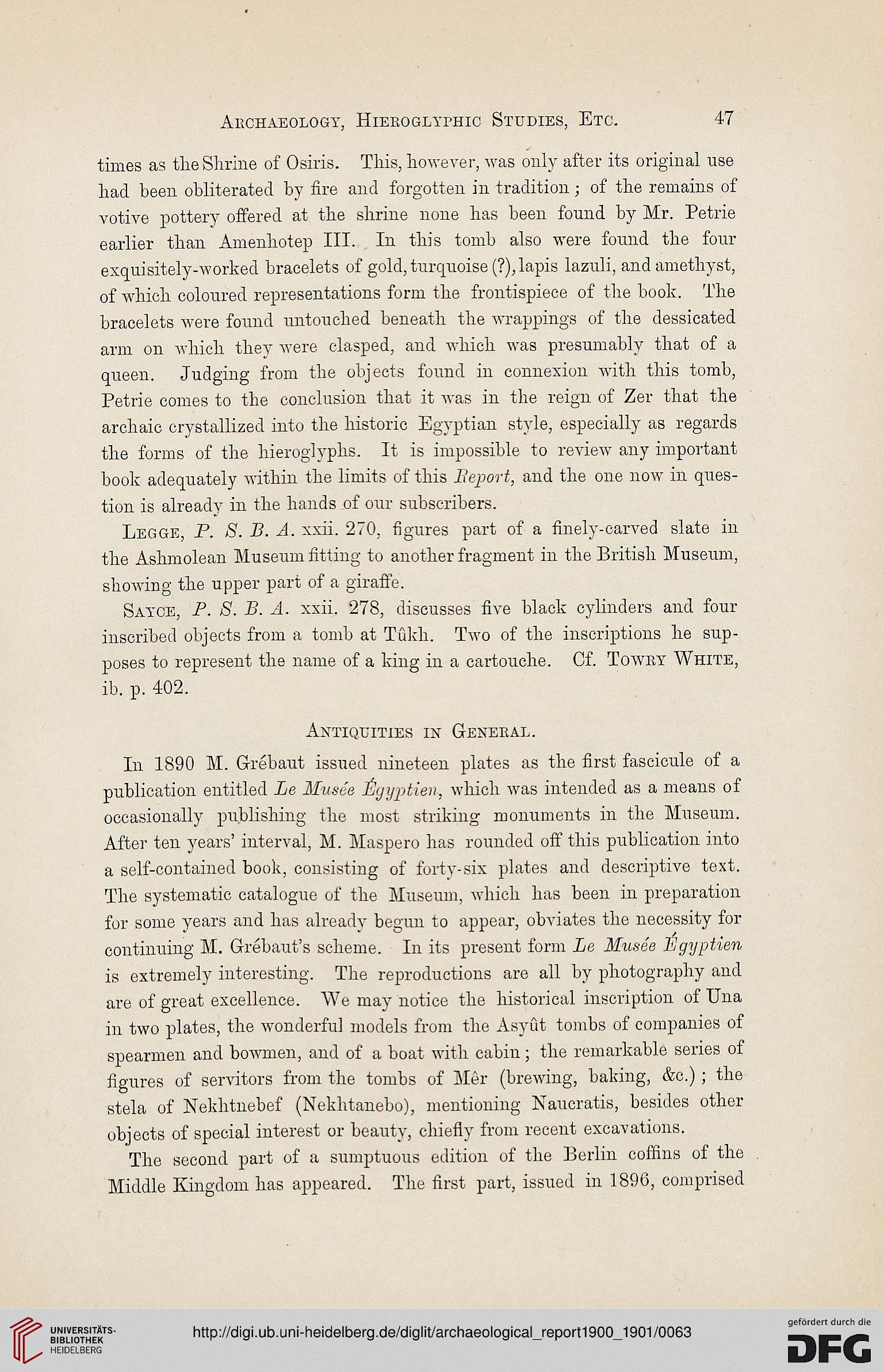Archaeology, Hieroglyphic Studies, Etc.
47
times as the Shrine of Osiris. This, however, was only after its original use
had been obliterated by fire and forgotten in tradition; of the remains of
votive pottery offered at the shrine none has been found by Mr. Petrie
earlier than Amenhotep III. In this tomb also were found the four
exquisitely-worked bracelets of gold, turquoise (?), lapis lazuli, and amethyst,
of which coloured representations form the frontispiece of the book. The
bracelets were found untoucbed beneath the wrappings of the dessicated
arm on which they were clasped, and which was presumably that of a
queen. Judging from the objects found in connexion with this tomb,
Petrie comes to the conclusion that it was in the reign of Zer that the
archaic crystallized into the historic Egyptian style, especially as regards
the forms of the hieroglyphs. It is impossible to review any important
book adequately within the limits of this lieport, and the one now in ques-
tion is already in the hands of our subscribers.
Legge, P. S. B. A. xxii. 270, figures part of a finely-carved slate in
the Ashmolean Museum fitting to another fragment in the British Museum,
showing the upper part of a giraffe.
Sayce, P. 3. 13. A. xxii. 278, discusses five black cylinders and four
inscribed objects from a tomb at Tukh. Two of the inscriptions he sup-
poses to represent the name of a king in a cartouche. Of. Towey White,
ib. p. 402.
Antiquities in General.
In 1890 M. Grebaut issued nineteen plates as the first fascicule of a
publication entitled Le Musee Egyptien, which was intended as a means of
occasionally publishing the most striking monuments in the Museum.
After ten years' interval, M. Maspero has rounded off this publication into
a self-contained book, consisting of forty-six plates and descriptive text.
The systematic catalogue of the Museum, which has been in preparation
for some years and has already begun to appear, obviates the necessity for
continuing M. Grebaut's scheme. In its present form Le Musee Egyptien
is extremely interesting. The reproductions are all by photography and
are of great excellence. We may notice the historical inscription of Una
in two plates, the wonderful models from the Asyut tombs of companies of
spearmen and bowmen, and of a boat with cabin; the remarkable series of
figures of servitors from the tombs of Mer (brewing, baking, &c.); the
stela of Nekhtuebef (Nekhtanebo), mentioning Naucratis, besides other
objects of special interest or beauty, chiefly from recent excavations.
The second part of a sumptuous edition of the Berlin coffins of the
Middle Kingdom has appeared. The first part, issued in 1896, comprised
47
times as the Shrine of Osiris. This, however, was only after its original use
had been obliterated by fire and forgotten in tradition; of the remains of
votive pottery offered at the shrine none has been found by Mr. Petrie
earlier than Amenhotep III. In this tomb also were found the four
exquisitely-worked bracelets of gold, turquoise (?), lapis lazuli, and amethyst,
of which coloured representations form the frontispiece of the book. The
bracelets were found untoucbed beneath the wrappings of the dessicated
arm on which they were clasped, and which was presumably that of a
queen. Judging from the objects found in connexion with this tomb,
Petrie comes to the conclusion that it was in the reign of Zer that the
archaic crystallized into the historic Egyptian style, especially as regards
the forms of the hieroglyphs. It is impossible to review any important
book adequately within the limits of this lieport, and the one now in ques-
tion is already in the hands of our subscribers.
Legge, P. S. B. A. xxii. 270, figures part of a finely-carved slate in
the Ashmolean Museum fitting to another fragment in the British Museum,
showing the upper part of a giraffe.
Sayce, P. 3. 13. A. xxii. 278, discusses five black cylinders and four
inscribed objects from a tomb at Tukh. Two of the inscriptions he sup-
poses to represent the name of a king in a cartouche. Of. Towey White,
ib. p. 402.
Antiquities in General.
In 1890 M. Grebaut issued nineteen plates as the first fascicule of a
publication entitled Le Musee Egyptien, which was intended as a means of
occasionally publishing the most striking monuments in the Museum.
After ten years' interval, M. Maspero has rounded off this publication into
a self-contained book, consisting of forty-six plates and descriptive text.
The systematic catalogue of the Museum, which has been in preparation
for some years and has already begun to appear, obviates the necessity for
continuing M. Grebaut's scheme. In its present form Le Musee Egyptien
is extremely interesting. The reproductions are all by photography and
are of great excellence. We may notice the historical inscription of Una
in two plates, the wonderful models from the Asyut tombs of companies of
spearmen and bowmen, and of a boat with cabin; the remarkable series of
figures of servitors from the tombs of Mer (brewing, baking, &c.); the
stela of Nekhtuebef (Nekhtanebo), mentioning Naucratis, besides other
objects of special interest or beauty, chiefly from recent excavations.
The second part of a sumptuous edition of the Berlin coffins of the
Middle Kingdom has appeared. The first part, issued in 1896, comprised




